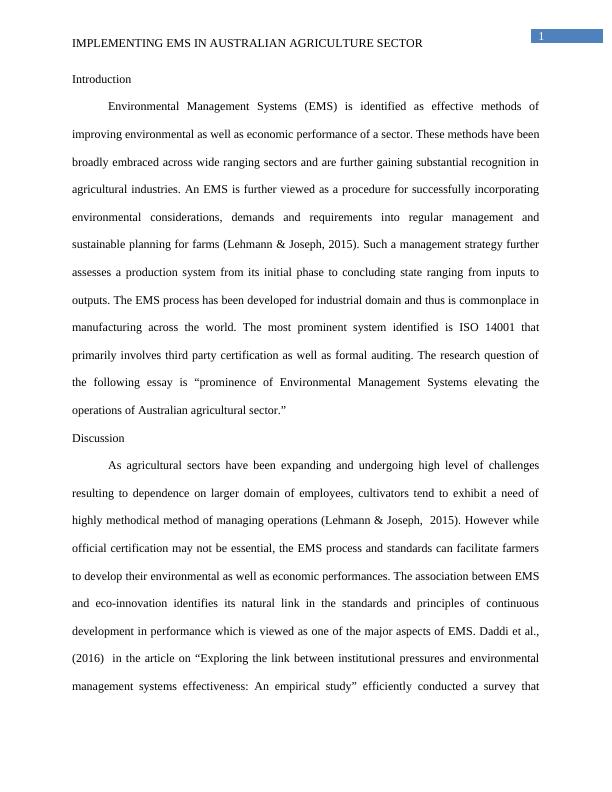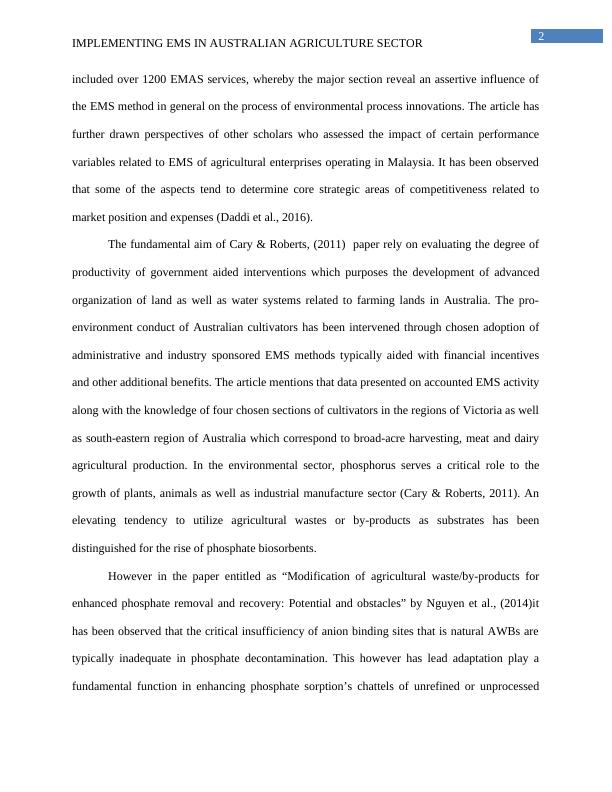Implementing EMS in Australian Agriculture Sector
Added on 2023-06-04
9 Pages2448 Words191 Views
Running head: IMPLEMENTING EMS IN AUSTRALIAN AGRICULTURE SECTOR
IMPLEMENTING EMS IN AUSTRALIAN AGRICULTURE SECTOR
Name of the Student:
Name of the University:
Author note:
IMPLEMENTING EMS IN AUSTRALIAN AGRICULTURE SECTOR
Name of the Student:
Name of the University:
Author note:

1
IMPLEMENTING EMS IN AUSTRALIAN AGRICULTURE SECTOR
Introduction
Environmental Management Systems (EMS) is identified as effective methods of
improving environmental as well as economic performance of a sector. These methods have been
broadly embraced across wide ranging sectors and are further gaining substantial recognition in
agricultural industries. An EMS is further viewed as a procedure for successfully incorporating
environmental considerations, demands and requirements into regular management and
sustainable planning for farms (Lehmann & Joseph, 2015). Such a management strategy further
assesses a production system from its initial phase to concluding state ranging from inputs to
outputs. The EMS process has been developed for industrial domain and thus is commonplace in
manufacturing across the world. The most prominent system identified is ISO 14001 that
primarily involves third party certification as well as formal auditing. The research question of
the following essay is “prominence of Environmental Management Systems elevating the
operations of Australian agricultural sector.”
Discussion
As agricultural sectors have been expanding and undergoing high level of challenges
resulting to dependence on larger domain of employees, cultivators tend to exhibit a need of
highly methodical method of managing operations (Lehmann & Joseph, 2015). However while
official certification may not be essential, the EMS process and standards can facilitate farmers
to develop their environmental as well as economic performances. The association between EMS
and eco-innovation identifies its natural link in the standards and principles of continuous
development in performance which is viewed as one of the major aspects of EMS. Daddi et al.,
(2016) in the article on “Exploring the link between institutional pressures and environmental
management systems effectiveness: An empirical study” efficiently conducted a survey that
IMPLEMENTING EMS IN AUSTRALIAN AGRICULTURE SECTOR
Introduction
Environmental Management Systems (EMS) is identified as effective methods of
improving environmental as well as economic performance of a sector. These methods have been
broadly embraced across wide ranging sectors and are further gaining substantial recognition in
agricultural industries. An EMS is further viewed as a procedure for successfully incorporating
environmental considerations, demands and requirements into regular management and
sustainable planning for farms (Lehmann & Joseph, 2015). Such a management strategy further
assesses a production system from its initial phase to concluding state ranging from inputs to
outputs. The EMS process has been developed for industrial domain and thus is commonplace in
manufacturing across the world. The most prominent system identified is ISO 14001 that
primarily involves third party certification as well as formal auditing. The research question of
the following essay is “prominence of Environmental Management Systems elevating the
operations of Australian agricultural sector.”
Discussion
As agricultural sectors have been expanding and undergoing high level of challenges
resulting to dependence on larger domain of employees, cultivators tend to exhibit a need of
highly methodical method of managing operations (Lehmann & Joseph, 2015). However while
official certification may not be essential, the EMS process and standards can facilitate farmers
to develop their environmental as well as economic performances. The association between EMS
and eco-innovation identifies its natural link in the standards and principles of continuous
development in performance which is viewed as one of the major aspects of EMS. Daddi et al.,
(2016) in the article on “Exploring the link between institutional pressures and environmental
management systems effectiveness: An empirical study” efficiently conducted a survey that

2
IMPLEMENTING EMS IN AUSTRALIAN AGRICULTURE SECTOR
included over 1200 EMAS services, whereby the major section reveal an assertive influence of
the EMS method in general on the process of environmental process innovations. The article has
further drawn perspectives of other scholars who assessed the impact of certain performance
variables related to EMS of agricultural enterprises operating in Malaysia. It has been observed
that some of the aspects tend to determine core strategic areas of competitiveness related to
market position and expenses (Daddi et al., 2016).
The fundamental aim of Cary & Roberts, (2011) paper rely on evaluating the degree of
productivity of government aided interventions which purposes the development of advanced
organization of land as well as water systems related to farming lands in Australia. The pro-
environment conduct of Australian cultivators has been intervened through chosen adoption of
administrative and industry sponsored EMS methods typically aided with financial incentives
and other additional benefits. The article mentions that data presented on accounted EMS activity
along with the knowledge of four chosen sections of cultivators in the regions of Victoria as well
as south-eastern region of Australia which correspond to broad-acre harvesting, meat and dairy
agricultural production. In the environmental sector, phosphorus serves a critical role to the
growth of plants, animals as well as industrial manufacture sector (Cary & Roberts, 2011). An
elevating tendency to utilize agricultural wastes or by-products as substrates has been
distinguished for the rise of phosphate biosorbents.
However in the paper entitled as “Modification of agricultural waste/by-products for
enhanced phosphate removal and recovery: Potential and obstacles” by Nguyen et al., (2014)it
has been observed that the critical insufficiency of anion binding sites that is natural AWBs are
typically inadequate in phosphate decontamination. This however has lead adaptation play a
fundamental function in enhancing phosphate sorption’s chattels of unrefined or unprocessed
IMPLEMENTING EMS IN AUSTRALIAN AGRICULTURE SECTOR
included over 1200 EMAS services, whereby the major section reveal an assertive influence of
the EMS method in general on the process of environmental process innovations. The article has
further drawn perspectives of other scholars who assessed the impact of certain performance
variables related to EMS of agricultural enterprises operating in Malaysia. It has been observed
that some of the aspects tend to determine core strategic areas of competitiveness related to
market position and expenses (Daddi et al., 2016).
The fundamental aim of Cary & Roberts, (2011) paper rely on evaluating the degree of
productivity of government aided interventions which purposes the development of advanced
organization of land as well as water systems related to farming lands in Australia. The pro-
environment conduct of Australian cultivators has been intervened through chosen adoption of
administrative and industry sponsored EMS methods typically aided with financial incentives
and other additional benefits. The article mentions that data presented on accounted EMS activity
along with the knowledge of four chosen sections of cultivators in the regions of Victoria as well
as south-eastern region of Australia which correspond to broad-acre harvesting, meat and dairy
agricultural production. In the environmental sector, phosphorus serves a critical role to the
growth of plants, animals as well as industrial manufacture sector (Cary & Roberts, 2011). An
elevating tendency to utilize agricultural wastes or by-products as substrates has been
distinguished for the rise of phosphate biosorbents.
However in the paper entitled as “Modification of agricultural waste/by-products for
enhanced phosphate removal and recovery: Potential and obstacles” by Nguyen et al., (2014)it
has been observed that the critical insufficiency of anion binding sites that is natural AWBs are
typically inadequate in phosphate decontamination. This however has lead adaptation play a
fundamental function in enhancing phosphate sorption’s chattels of unrefined or unprocessed

End of preview
Want to access all the pages? Upload your documents or become a member.
Related Documents
Environmental management Systems PDFlg...
|10
|2179
|24
Importance of Environment Management System in Australian Agricultural Sectorlg...
|11
|2318
|223
Implementing EMS in the Australian Agriculture Sectorlg...
|9
|2364
|348
Implementation of Environmental Management Systemlg...
|9
|2284
|243
Implementation of Environment Management System in Australian Agriculture Sectorlg...
|10
|2215
|313
Implementing Environmental Management Systems in the Australian Agriculture Sectorlg...
|8
|2230
|471